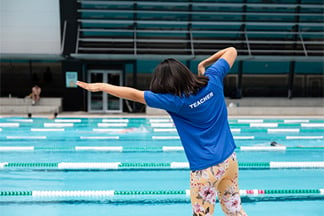Login to the E-Learning Centre:
Not an AUSTSWIM student yet?
Learn more about our online swim training here
Not an AUSTSWIM student yet?
Learn more about our online swim training here



INFANT AND PRESCHOOL AQUATICS

TOWARDS COMPETITIVE STROKES

PROFESSIONAL DEVELOPMENT
40+ years’
experience
specialising in
teacher training
Courses developed
in collaboration
with industry
for industry
The best, most
comprehensively
trained course presenters
The most
comprehensive
knowledge, skills
and understanding
Most training
options to support
and grow your
programs
The largest network
of teachers,
candidates and
swim schools
Trained Teachers since 1979
Trained Teachers in 2023
AUSTSWIM Courses held in 2023
Using an AUSTSWIM School of Excellence ensures quality assurance and provides peace of mind. Look for the Accredited AUSTSWIM Teacher's sticker and current Premium or Platinum AUSTSWIM School of Excellence Certificate when you visit a pool to ensure that only AUSTSWIM Licensed Teachers are provided.
Be a part of the largest swimming and water safety network of teachers, candidates and swim schools. Keep your finger on the pulse and maintain your teaching status. AUSTSWIM provide AUSTSWIM Licensed Teachers with ongoing training and professional development opportunities to add to their toolbox.

I’VE ALWAYS BEEN PROUD TO BRING GREATER AWARENESS TO AUSTSWIM, AND 2024 IS A SPECIAL YEAR FOR ME AS I’M PROUDLY CELEBRATING 16 YEARS AS AN AUSTSWIM AMBASSADOR. SWIMMING, WATER SAFETY AND THE IMPORTANCE OF WATER AWARENESS IN, ON AND AROUND ALL AQUATIC ENVIRONMENTS NEEDS TO BE AN INTEGRAL PART OF LIVING IN AUSTRALIA.

BROOKE HANSON - AUSTSWIM Ambassador